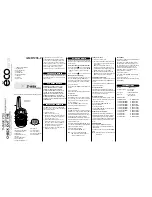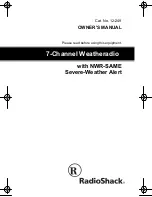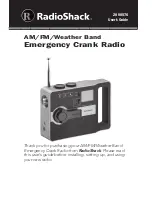
4
5
Inspired by
- Only adults should replace batteries.
- Do not mix battery types or old and new batteries.
- Do not use rechargeable batteries.
- Nonrechargeable batteries are not to be
recharged.
- Batteries are to be inserted with the correct
polarity.
- Do not short-circuit the supply terminals.
- Remove exhausted batteries from the walkie talkies.
- When walkie talkies are not in use, remove batteries
to prevent possible leakage.
- Use only recommended or equivalent battery types.
- Do not dispose of batteries in
fire: batteries may explode
or leak.
• Your walkie talkies should work up to 3km apart.
However, please note that they will work best in
an open area. Adverse weather conditions and the
environment in which they are being used can
affect the range.
• Avoid getting your walkie talkies wet, as water
and damp can affect or damage the electronics.
• Avoid hitting or dropping your walkie talkies against a
hard surface, as this can dislodge electrical components.
• Your walkie talkies have been fully adjusted prior to
leaving the factory. Do not touch or attempt to
modify/adjust the internal components.
• If the sound becomes weak, try changing the batteries,
or check the troubleshooting guide below.
• Remember to turn off by pressing the ON/OFF button for
2–3 seconds (until the display goes blank).
• Keep or store your walkie talkies in a dry, clean place.
IMPORTANT INFORMATION
Troubleshooting Guide
IMPORTANT INFORMATION
– Safe Battery Usage
These are great walkie talkies for
outdoor adventures with friends and
family. See how far apart you can be and
still hear each other. But first do not
forget to tell an adult where you are
going! Take them when you go camping,
on bike rides or long walks.
Adventures!
Problem
Solution
Interference or
fading message
Move away from any buildings, large structures, street lights or
overhead power lines, as these can cause interference.
Make sure the antenna is pointing up.
Move closer together; you may be out of range.
Make sure walkie talkie is at least 4-5 cm from your mouth.
No message is
being received
Make sure both handsets are switched on.
Make sure that the batteries are inserted properly and that they
aren’t low on power; replace if necessary.
Check that the person receiving isn’t pressing the TALK button.
Make sure that the person sending is pressing the TALK button.
Radio signals are
made up of two kinds
of waves: ‘sound’ waves,
which represent the sounds
being sent to the listener
and ‘electromagnetic’
waves, which travel with
sound waves to carry
them to your walkie
talkie.
When you speak
into a walkie-talkie it
converts your voice into a
radio signal and transmits it
to the receiver on the other
walkie talkie. When the signal
is picked up at the other end,
the walkie talkie turns it
back into speech so your
friend can hear it.
CALL ALERT
& PRESS
TO TALK
BUTTONS






















